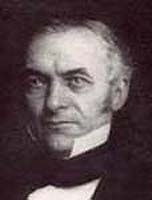|
Read works of Prosper Mérimée at 小说之家 |
Life
Prosper Mérimée was born in Paris. He studied law as well as Greek, Spanish, English, and Russian. He was the first interpreter of much Russian literature in France.
Mérimée loved mysticism, history, the unusual, and the mystification (in the latter he was influenced by Charles Nodier), the historical fiction popularised by Sir Walter Scott and the cruelty and psychological drama of Aleksandr Pushkin. Many of his stories are mysteries set in foreign places, Spain and Russia being popular sources of inspiration.
In 1834, Mérimée was appointed to the post of inspector-general of historical monuments. He was a born archaeologist, combining linguistic faculty of a very unusual kind with accurate scholarship, with remarkable historical appreciation, and with a sincere love for the arts of design and construction, in the former of which he had some practical skill. In his official capacity he published numerous reports, some of which, with other similar pieces, have been republished in his works.
Mérimée met and befriended the Countess of Montijo in Spain in 1830 whom he credited as being his source for the Carmen story. Together with the countess, he coached her daughter, Eugenie, during the courtship with Napoleon III (though his correspondence indicates he was opposed to their marriage). When the daughter became the Empress Eugénie of France in 1853 he was made a senator.
In 1841, Prosper Mérimée and his friend George Sand made a major contribution to the history of medieval art by discovering the luminous tapestries of The Lady and the Unicorn during a stay at the Château de Boussac in the Limousin district of central France, which entered immediately into history thanks to the writings of George Sand.
Prosper Mérimée died in Cannes, France and was interred there in the Cimetière du Grand Jas.
Works
* Cromwell (1822) - his first play. It was never published and no copies exist. Mérimée felt its similarities with contemporary French politics were too obvious and he destroyed the manuscript.
* Le Théâtre de Clara Gazul (1825) - a hoax, supposedly a translation by one Joseph L'Estrange of work written by a Spanish actress. These plays, written before Hugo's Hernani, can be considered early examples of French "romanticisme" as defined by Mérimée's friend Stendhal in his Racine et Shakespeare.
* La Guzla (1827) - another hoax, ballads about various mystical themes purportedly translated from the original "Illyrian" (i.e. Serbo-Croatian) by one Hyacinthe Maglanowich. These ballads had considerable influence, translated into Russian, notably by Pushkin and Lermontov.
* La Jacquerie (1828) - dramatic scenes about a peasant insurrection in feudal times.
* La Chronique du temps de Charles IX (1829) - a novel set at the French court at the time of the St. Bartholomew massacre (1572).
* "Mateo Falcone" (1829) - a short story about a Corsican man who kills his son in the name of justice (made into an opera of the same name by the Russian composer César Cui)
* Le Carrosse du Saint Sacrement (1829) - a comedy about a theatrical troupe (made into the film The Golden Coach by Jean Renoir)
* Mosaïque (1833) - a collection of short stories, containing: "Mateo Falcone", "Vision de Charles XI", "L'enlèvement de la redoute", "Tamango, "Le fusil enchanté", "Federigo", "Ballades", "La partie de trictrac", "Le vase étrusque", "Les mécontens". It also includes three of his letters from Spain. Most of these tales were previously published in the Revue de Paris in 1829 and 1830.
* Les âmes du Purgatoire (1834) - a novella about the libertine Don Juan Maraña.
* La Vénus d'Ille (1837) - a fantastic horror tale of a bronze statue that seemingly comes to life.
* Notes de voyages (1835-40) - describing his travels through Greece, Spain, Turkey, and France.
* Colomba (1840) - his first famous novella about a young Corsican girl who pushes her brother to commit murder to avenge their father's death.
* Carmen (1845) - another famous novella describing an unfaithful gypsy girl who is killed by the soldier who loves her (made into an opera by Georges Bizet in 1875).
* Lokis (1869) – set in Lithuania, it is the horror story of a man who, it would seem, is half bear and half man and enjoys feasting on human flesh. The title means "bear" in Lithuanian, but has a misspelling ("Lokys" would be the correct form).
* La Chambre bleue (1872) - a farce that has all the trappings of a supernatural tale but in the end turns out to be anything but.
* Lettres à une inconnue (1874) - a collection of letters from Mérimée to Jenny Dacquin, published after his death.
Critics
* Articles on Nikolai Gogol (1852), Alexander Pushkin (1868), Ivan Turgenev (1868)
Translation from Russian
* La Dame de pique (The Queen of Spades, "Пиковая дама"), Les Bohémiens (The Gypsies, "Цыганы"), Le Hussard ("Гусар") (1852), from Pushkin.
* L'Inspecteur général (1853) from Gogol's The Government Inspector ("Ревизор").
* Le Coup de pistolet ("Выстрел") (1856), from Pushkin.
* Apparitions ("Призраки") (1866), from Turgenev.
